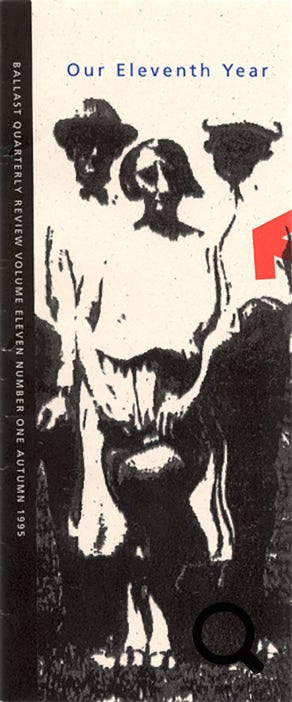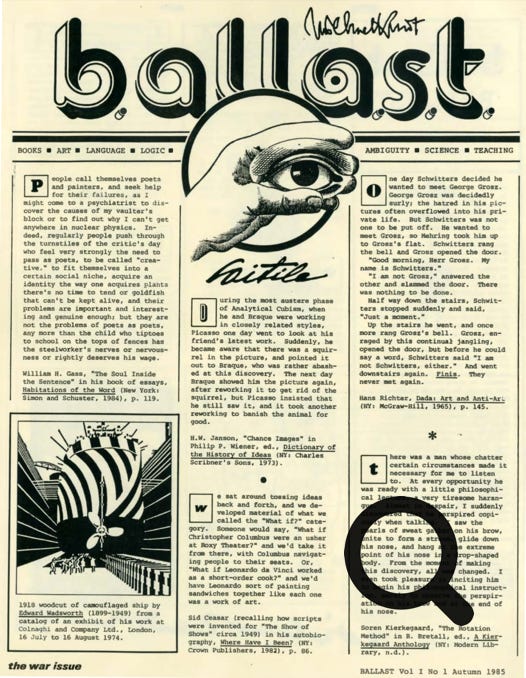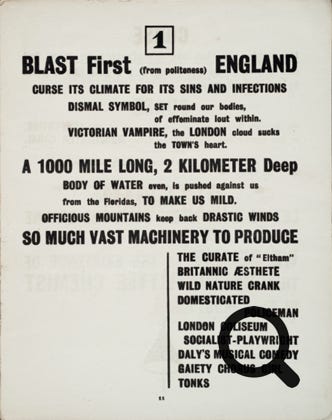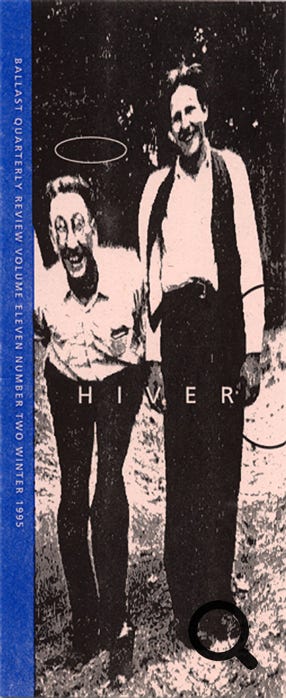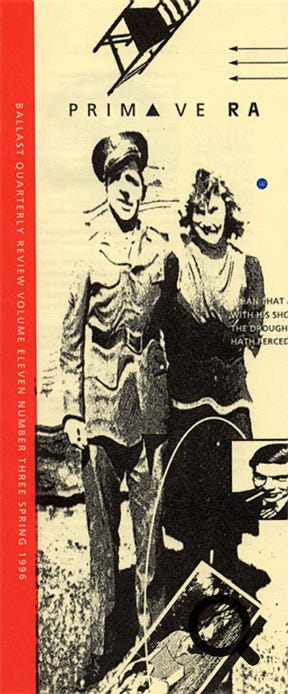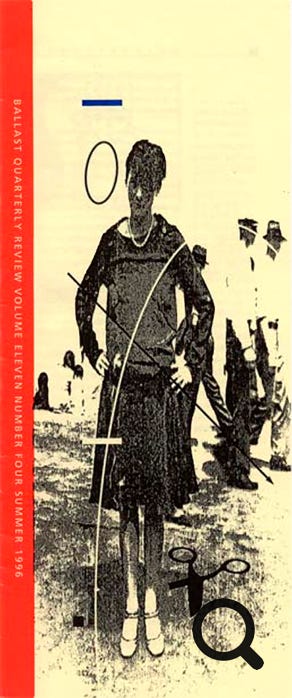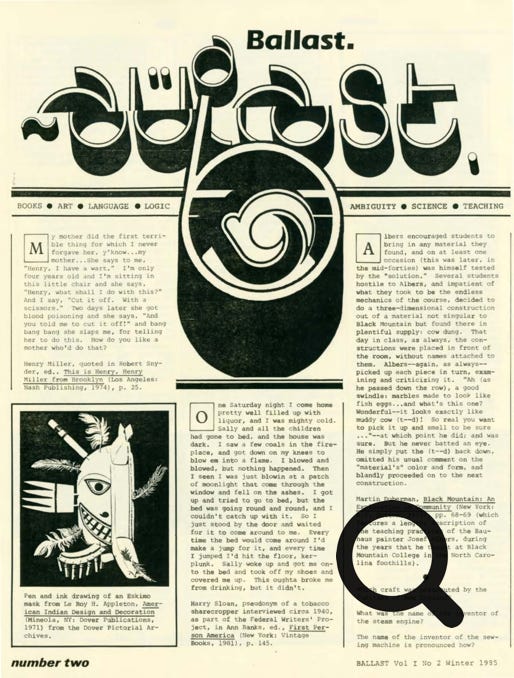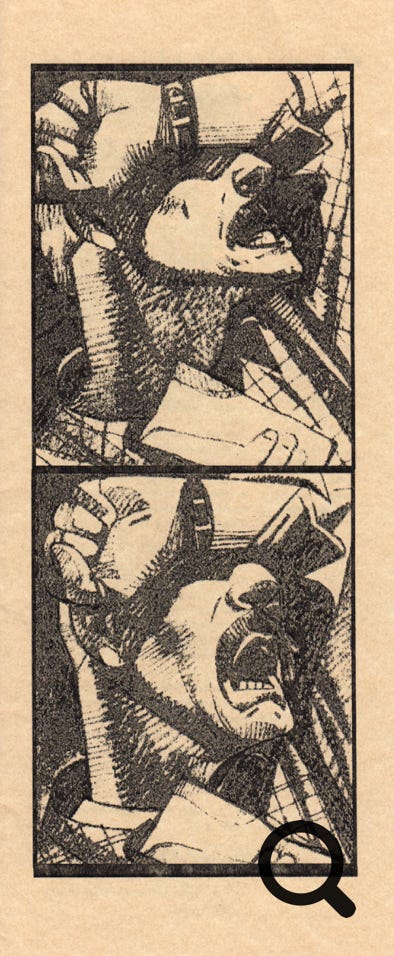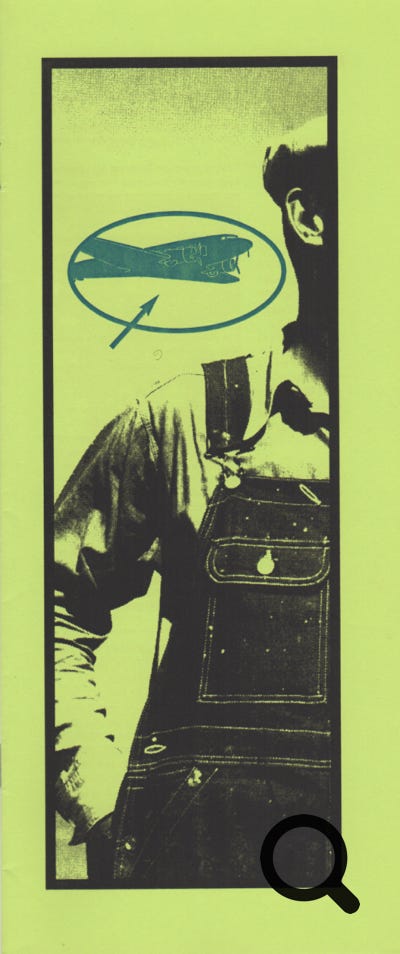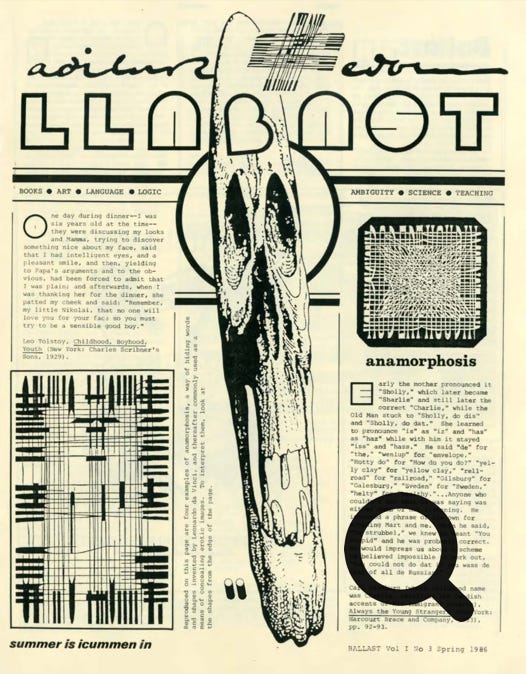Groucho Marx—
Outside of a dog, a book is man’s best friend. Inside a dog, it’s too dark to read.
Ballast Quarterly Review was a periodical commonplace book that began publication in 1985. Its title is an acronym for Books Art Language Logic Ambiguity Science and Teaching, as well as a distant allusion to BLAST, the short-lived publication founded during World War I by British author P. Wyndham Lewis, a Vorticist artist and writer. It ceased publication in 2006.
BALLAST was mainly a pastiche of astonishing passages from books, magazines, diaries and other published writings. Put differently, it was a journal devoted to wit, the contents of which were intended to be insightful, amusing or thought provoking.
Reprinted on this page is an interview with the magazine’s founding editor and publisher, Roy R. Behrens, conducted by independent media critic Barry Pye in 2002. Copyright © by Bobolink Books. All rights reserved.
Above and right The first three issues of Ballast Quarterly Review (1985-1986)
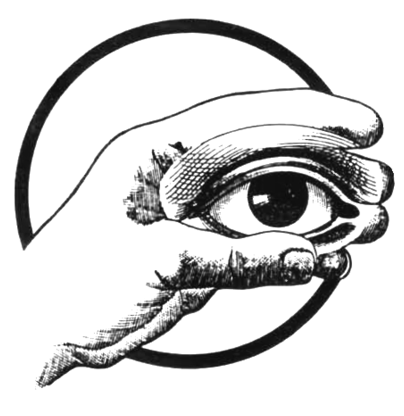
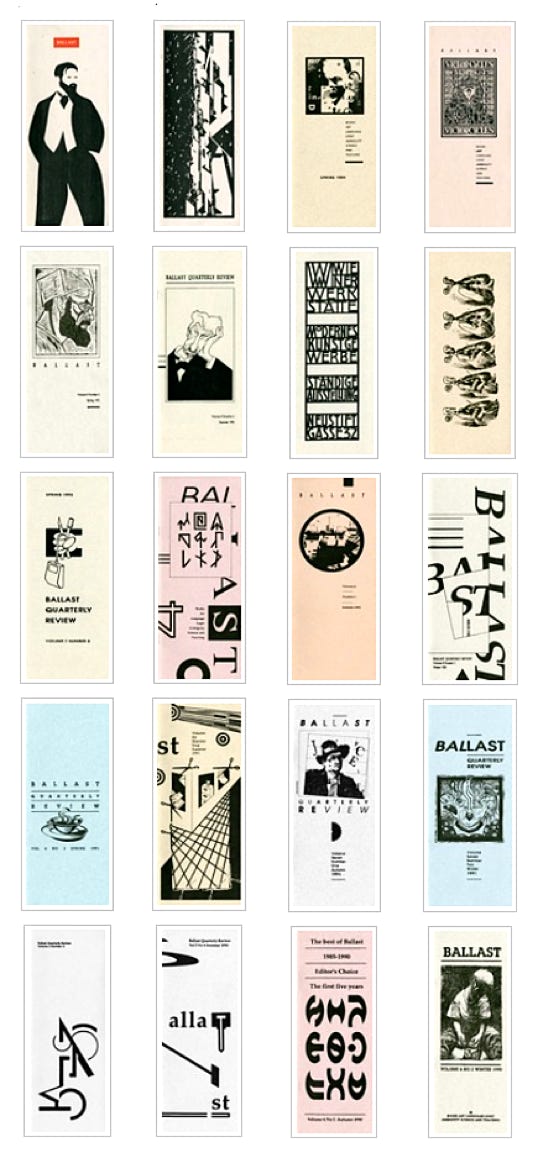
Above All issues of BALLAST have been posted online where they can be viewed on screen or downloaded as printable pdfs.The printed originals are in the collection of the Rod Library at the University of Northern Iowa. Click here to access the files.
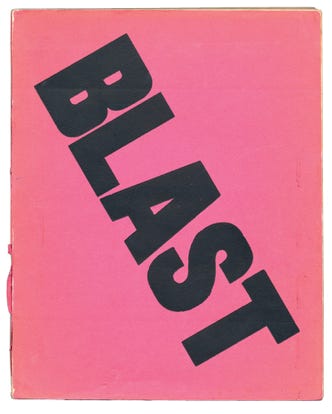
Agnes Elizabeth Benedict (Progress to Freedom)—
Whenever some one speaks with prejudice against a group—Catholics, Jews, Italians, Negroes—someone else usually comes up with a classic line of defense: “Look at Einstein!” “Look at Carver!” “Look at Toscanini!” So, of course, Catholics (or Jews, or Italians or Negroes) must be all right. They mean well, those defenders. But their approach is wrong. It is even bad. What a minority group wants is not the right to have geniuses among them but the right to have fools and scoundrels without being condemned as a group.
Editor’s note: It was not often that current events (world or otherwise) were referred to in an issue of BALLAST. But in at least two cases, there are implicit references on the covers to events that were concurrent with that issue. On the far right, as foretold by the airplane, is a cover that alludes to the attack of 9-11. And the issue next to that (with sequential thumbnail drawings by Gary Kelley) refers to a farming accident in which I was struck in the eye by a rock or piece of metal while mowing the lawn. Despite numerous surgeries, I eventually lost that eye.—RB
James Joyce
In gutter dispear I am taking my pen toilet you know that, being leyde up in bad with the prevalent distemper I opened the window and in flew Enza.
Gerald Brenan
(Thoughts in a Dry Season)—
A cow does not know how much milk it has until the milkman starts working on it. Then it looks round in surprise and sees the pail full to the brim. In the same way a writer has no idea how much he has to say till his pen draws it out of him. Thoughts will then appear on the paper that he is amazed to find that he possessed.
William James
The moral flabbiness born of the executive worship of the bitch-goddess success. That—with the squalid cash interpretation put on the word success—is our national disease.
Above The covers of the four issues for Volume 11 of Ballast Quarterly Review (1995-1996)
HOW BALLAST BEGAN
Question: So how did BALLAST begin?
Answer: In the late 1960s, when I (of all people) was drafted into the U.S. Marine Corps, I found that some of the officers, while cruel and unusual, could also be terribly funny. One of my favorites was a height-impaired captain, a George Gobel look-alike, who was the company adjutant when I was in Hawaii. He was hilarious—always. One day a top-ranking officer came to our company (a Marine general), and this adjutant sent word that I should report to his office immediately. As I stood frozen at attention (awed by the mere presence of such a distinguished warrior), the captain turned to him and said, “General, the sergeant here is a very curious specimen. He is college-educated, and, as a result, is completely unable to answer any question with a simple yes-or-no answer.” And then, turning to me, he asked, “Isn’t that true, Sergeant?” After a measured pause, I slowly and thoughtfully answered, “Well, not entirely, Sir. You see, there’s this and that and that and that…” and of course, to his delight, I droned on for a couple of minutes.
Q: That’s a great story. But how did BALLAST begin?
A: In part, I’m avoiding the question because I don’t think I fully remember. It began in the fall of 1985, when I was living in the [fictional] state of [let’s say, Woonsocket]. Mary and I had married a few years earlier, and we were living in an upstairs flat, just a couple of blocks from the university at which I was teaching. The economy was in a steep nose dive. I rarely even think about salaries, but, for several years, the university faculty hadn’t received any raises, not even to offset the rapid accent in the cost of living. So I was increasingly down in the mouth.
At about the same time, I received a memo from a local organization, called the Independent Performance Artists of [Woonsocket, let’s say], commonly shortened to IPAW, a faintly comic acronym. No doubt wanting to be less comical and more corporate (in the hope of attracting some serious donations), they decided to adopt a logo. So the memo announced a logo design competition in which the winning student would be given $50, a miserly amount, even in those days.
In a moment of droll inspiration, I decided that, in addition to passing on this golden opportunity to my students, I myself should enter the contest, to supplement my salary. So I came up with a wonderful logo (a collage somewhat inspired by Max Ernst) [as reproduced above left], in which, instead of avoiding it, I played up the well-known IPAW name (eye-paw or eye-hand) as a symbol of the organization’s visual-kinesthetic objective. I then sent it through the mail to the judges, with an explanatory letter (written in comically broken English) in which I claimed to be a visiting student from France named Raymond Sélavy. I explained that I did not have an American bank account, so that, if I won the prize, the check for $50 should be made out to my design professor, Professor Behrens, and mailed to his home address.
Q: Did you win the contest?
A: No such luck, it seems—Sélavy’s lovely logo lost (with apologies to Spiro Agnew, whose relative was once a student of mine). To make matters worse, it turned out that a faculty colleague (whose tastes and ideas I did not agree entirely with) assigned this same logo problem to his entire class, and it was one of his students who won the contest. After the judging, all the logo entries (including the work of poor Raymond) were mistakenly returned to this faculty colleague, in a single stack. Not expecting an alien among them, he then absentmindedly graded all of them, so that when I got it back (I found it in a pile in the corner of the classroom) Raymond Sélavy’s logo not only lost the contest but also had a discouraging grade of C or C- written on the back. So there I sat with a beautiful form with no function.
Q: Another great story, but, again, what does this have to do with BALLAST?
A: Well, actually, it has everything to do with it. Because it was at that moment that I decided to launch a magazine, in which I could make use of that award-losing logo—and that’s exactly what I did.
Q: But how did you fund a magazine? I thought you were worried about
your salary.
A: Well, I sidestepped the funding problem. In part I was able to do it because BALLAST was never intended to be a legitimate magazine; it was simply a “zine” long before that became fashionable, or even heard of. When it began, BALLAST consisted of 8 pages, each measuring 8.5 x 11 inches. So I only had to print two sheets of 11 x 17, back to back, using black ink only, which was very affordable in those days. This was before the widespread use of personal computers, so I made the headlines with rub-on letters and the text with an IBM selectric typewriter. Everything was pasted-up on a larger board, then reduced in the process of printing. The greatest expense, I soon realized, was the cost of first class postage. So I announced that the magazine itself would be free to subscribers, but the postage would not. That’s how I started the policy of asking for a certain number of stamps for each issue. Over the years, I’ve gradually increased the number of stamps, but I then use the surplus to cover the costs of a certain number of influential freeloaders, as well as support for my other research.
Q: And how many subscribers did you end up with?
A: By the second year, the mailing list was around 500. In the years since, it has been as high as 600 and as low as 400, but it remains fairly consistent. I built it up by mailing the inaugural issue to various people (especially artists and writers) whom I thought might be interested, and to a small number of magazine reviewers. I began to get lots of subscription requests after it was featured in Whole Earth Catalog, Communication Arts, AIGA Journal and other magazines. Another major, constant source is gift subscriptions, when people send in stamps for friends.
Q: So that’s the whole story? It was as simple as that?
A: Well, not really. There were lots of peripheral things going on that I haven’t mentioned. For example, it was a common belief at the time (and maybe even more so now) that if you were a “visual” artist, you could not or should not be “verbal.” I knew that that was historically false, and that, in times other than our own, there has often been great interest in reading and writing among visual artists. That was one of the reasons why I chose as the magazine’s title the acronym BALLAST (for Books Art Language Logic Ambiguity Science and Teaching), which is a deliberate reference to BLAST [shown at left], the British art and literary magazine founded in 1914 by Wyndham Lewis (an artist as well as a writer) and the poet Ezra Pound.
Q: Any other hidden agendas?
A: For years I had used my [University of Woonsocket] office door as a place for posting excerpts from books that I had run across while writing textbooks. It was a busy hallway, and when my door was propped open, clusters of students would gather around to read the latest postings. These same brief passages and quotes became the contents of the first issues. The idea that BALLAST would be a “periodical commonplace book” (and there’s no better description of it than that) was perhaps the key ingredient in maintaining the quality of its contents, because I certainly don’t have the time, the funding, nor the creative resources to provide enough strong material for four issues, year after year.
Q: Did the choice of the word ballast have any other significance?
A: As a nautical term, ballast refers to the various weights (stones, slag, gravel) that are carried in the holds of ships, to insure their stability. It occurred to me that the contents of BALLAST (small but nonetheless weighty remarks from journals, autobiographies, and so on) might provide an analogous function—for me certainly, but also, I hoped, for subscribers. In my case, as editor, I also derive some stability from having to browse constantly for new material. For 18 years, it hasn’t stopped. Day after day, month after month, I am always working toward a new deadline, always preparing the next issue. The pressure is sometimes annoying, even painful, but it’s also stimulating. You can imagine how much I’ve evolved, intellectually and otherwise, from constantly having to search for new material.
Q: Do you ever think about quitting?
A: Only once or twice a week. Actually, I find it almost a total delight to gather material for an issue and to design it. Those are the invigorating aspects. The tiresome tasks are the printing (which I do myself on a laser printer), collating, stapling, trimming, tabbing, and applying the stamps and the mailing labels, all of which I do by hand. I know it is and often looks like a cheaply printed piece of junk, but the entire process of producing it is far more costly than people realize, so I do what I can to save money. But, admittedly, it’s during all the hand labor that I become disenchanted, and vow that I’ll someday abandon the thing—and then I receive an appreciative note from a subscriber or two, and begin work on the next issue. I really do get some wonderful notes from subscribers, and sometimes they’re accompanied by a check or a bottle of Glenlivet. Those who donated neither stamps, nor checks—nor even Glenlivet—were described in the magazine’s office as having gotten off “scotch-free.”
Q: Your day job is that of a teacher. What does that have to do with BALLAST?
A: I think it has everything to do with it. So much that, to great extent, the two are inseparable. Sometimes I think of BALLAST as a storehouse of especially memorable thoughts that I would love to pass on to students, but which I can’t easily share, because they’re rarely interested, and to force it on them would get tiresome for both of us. Of course, I do use some of the material in my lectures, but mostly I simply commit it to print. Also, I suspect that the process of gathering things (of digging up new material for each issue) contributes to the freshness of my teaching and prevents me from burning out. Like everything else in American life, there is always the danger that education will be reduced to the lowest common denominator, so that (just like literature and art) it can be used for commercial, non-educational purposes. The major current threats are from robotic job training on the one hand and mindless therapeutic play on the other. In its finest moments, teaching is an exalted activity, but it’s easy for teachers to be overcome by routine and trivia. One of the functions of BALLAST may be, as Viktor Shklovski would say, to reawaken our senses (or maybe it’s only my senses) and thereby to “make the stone stony” again.
Q: I remember somewhere you once wrote that “one learns more from teaching than one learns from being taught.” Is that relevant to all this?
A: Very much so. The primary value of BALLAST for me is that it’s an autodidactic endeavor (thank you, Walter Hamady!)—I teach myself by doing it, or, better yet, I evolve intellectually by producing it. In that sense, it doesn’t really matter if anyone else reads it, subscribes or whatever, since all that has already happened long before I mail it out. But there’s still another dimension, and that is that it also serves as a tribute to my own teachers—I’m thinking of ten or maybe more—who taught me one important thing: They made me realize that I should never wait for someone else to teach me, but rather I should teach myself. I clearly remember those teachers. I often think of them in the classroom, because they are the reason I’m driven to teach. And they’re one of the reasons for BALLAST as well.
Q: Oh-oh, we’re almost out of tape. I guess we’d better end it there.
•••
As published originally in BALLAST Quarterly Review (Vol 18 No 2), Winter 2002-03
